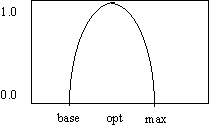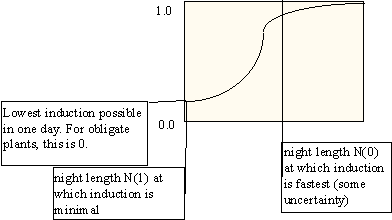Garden with Insight v1.0 Help: Plant Flowering and Fruiting Submodel
Note: This was originally written as a design document, so there may be some small
discrepancies between the processes described here and the actual model in Garden with Insight. The
main gist of the submodel is in agreement, though.
This section describes the Garden with Insight flowering and fruiting submodel. The model of plant
life-stage development follows these stages:
period description switch to next period
pre-emergence before germination germination
vegetative period no sensitivity to inductive forces HUI = 0.2
(photoperiod and temperature)
floral induction sensitivity to inductive forces accum. photothermal units = critical value
(photoperiod and temperature)
floral initiation creation of flower buds accum. thermal units = critical value
(allocation to reproductive sink starts)
Vegetative Phase
During the vegetative phase, no photoinduction is possible. The duration of the vegetative phase is in
terms of the heat unit index (HUI) for the cultivar. This will be a parameter but without any knowledge of
this it will be set at 0.2 initially for all plants. For biennial plants, this parameter will be applied only in
the second year, after the heat units have been reset to zero in the winter.
Floral Induction
Once the HUI reaches the end of the vegetative phase, photoinduction is calculated as follows. Most
of this is from SOYGRO (Jones et al. 1991).
On each day, R(t), the rate of development towards flowering, is calculated thus:
R(t) = F(T) x F(N)
where F(T) is a temperature function and F(N) is a night-length function. The temperature function F(T)
is exactly EPIC's temperature stress function with this form:

Relationship between temperature and floral induction
Usually there will be no information on what are the base, optimal and max temperatures for
flowering, but we will have these as parameters anyway, for special cases when we do know them.
Normally we will just copy the overall temperatures for the plant.
The night length function F(N) can have three forms:
a. For a day-neutral plant, F(N) = 1.0 always.
b. For a short-day plant (which is a long-night plant), the function looks like this:

Relationship between night length and floral induction
This can be done in the same way as other EPIC s curves, with parameters for x and y of two points
on the curve (the x's will be the night lengths and the y's will be between 0 and 1).
c. For a long-day plant (which is a short-night plant), the function looks is similar only the slope is
reversed. Defaults for these parameters will be: minimum floral induction units per day: 0.1; optimum
night length for floral induction: 12.0; critical night length for floral induction: for short-day (long-night
plants) 5.0, for long-day (short-night) plants minimum night length. These defaults are all from the
SOYGRO model.
You can see that both F(T) and F(N) range between 0 and 1, so multiplying them will also give a number
between 0 and 1. Each day R(t) will be summed, and when the sum equals R, the photothermal units
required for flowering, floral induction will be complete. The photothermal units required for floral
induction parameter will originally be set at 7.0 which is an average of the R values used in SOYGRO
(6.85).
This could also be done with the S curve function in EPIC.
Vernalization
For biennial plants that require vernalization (onions, lettuce, cabbage, etc), a thermal time scheme
is used to accumulate vernalization units. The same function as for floral induction and
temperature stress is used, with minimum, optimum and maximum temperatures for vernalization as
parameters. Vernalization units are accumulated over each day the mean temperature falls within the
range of correct temperatures. When the plant reaches the end of its vegetative period in the biennial
plant's second year, its accumulated vernalization units will affect its flowering.
1. If the cultivar requires vernalization for flowering (is obligate) and the vernalization units accumulated
are less than the units required, it will not flower. It will not even attempt to accumulate photothermal
units.
2. If the cultivar is quantitative in its response to vernalization, the photothermal units required for
flowering will be affected by vernalization units according to this equation:
photothermalUnitsRequiredForFloralInduction *= vernalizationUnitsRequired /
vernalizationUnitsAccumulated
So a partial vernalization will make the plant flower later or possibly not at all, but it will not switch off
flowering completely if the vernalization was near completion.
Parameters for this will be: vernalizationIsRequired (default: not required);
vernalizationObligateOrQuantitative (default: quantitative); min temp for vernalization (default: 0.0);
optimal temp for vernalization (default: 2.5); max temp for vernalization (default: 5.0); and vernalization
thermal units required (default: 45). Most defaults here are from Manipulation of Flowering (Atherton
1987). Looks like information on this can be found for most crop families.
Floral Initiation
After floral induction is complete, a period of floral initiation will occur when the plant will be
creating reproductive buds. The duration of this period will be in terms of thermal days, which are
calculated by the same function as is used for the thermal portion of floral induction. This will be a
parameter which will be initially set for all plants at 13 thermal days, based on the average value in
SOYGRO of 12.86 days. Supposedly some species are also sensitive to photoperiod in this phase, but it's
better to ignore that for now. Shorter-lived species will probably want to use a smaller number of days for
this parameter. It would also be possible to use HUI for this, in that an increase of 0.1 of HUI would be
sufficient, but HUI does not penalize high temperatures, which can ruin floral initiation.
For more information on Garden with Insight extensions to the EPIC model, see the section on the plant biomass partitioning model.
This software product, including its online help system and all printed documentation, is
Copyright (c) 1997 Paul D. Fernhout and Cynthia F. Kurtz All Rights Reserved.
Garden with Insight is a trademark of Paul D. Fernhout and Cynthia F. Kurtz.
| 
